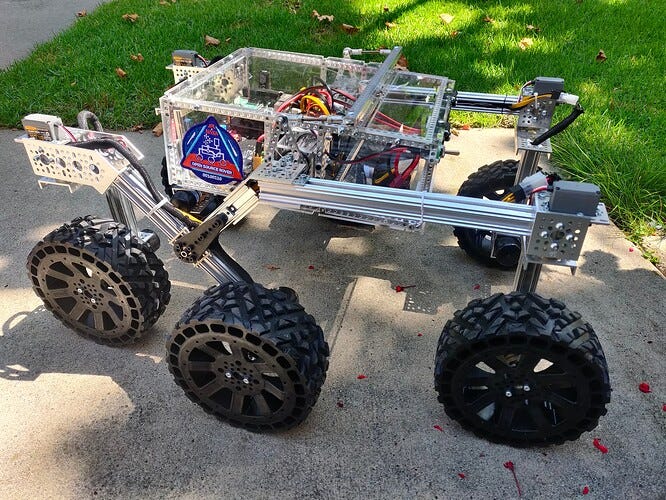The Secret Sauce Behind The Robot Revolution
Open source makes robotics tools, code, and hardware accessible to developers around the world.
Welcome back to Open Pioneers #36 - your weekly notes on open source.
Robotics is on the rise and likely going be the next frontier technology after AI. Now that we have access to cheap machine intelligence, we also want to deploy this intelligence to redundant physical tasks currently done by humans - assembling cars, delivering parcels, or baking pizza.
A main driver behind the upcoming robot revolution is open source.
Open Source is a Catalyst for Robotics
Not long ago, building a robot meant starting from scratch or relying on proprietary systems. Now, thanks to open source frameworks, every builder with a laptop can leverage world-class tools and building blocks. By openly sharing everything from motor drivers to perception algorithms, developers can avoid reinventing the wheel and focus on new ideas. When one lab or hobbyist improves a navigation algorithm, the whole community can benefit almost immediately.
At the core of modern robotics is the Robot Operating System (ROS), which provides the essential software “plumbing” for robot applications. With its massive library of community-contributed code and a permissive license, ROS lets companies prototype and deploy robots faster instead of developing every component from scratch.
Equally important are tools like Gazebo simulator (for realistic robot simulation) and libraries like OpenCV (giving robots vision), which integrate seamlessly with ROS. There are also countless niche projects maintained by the community – from ROS packages for drone control to middleware like Open-RMF for coordinating multi-robot systems.
Together, these openly shared platforms form a rich ecosystem; a developer encountering a new problem can often find that someone has already shared a solution.
Lowering the Entry Barriers for Building Robots
Open platforms put advanced robotics capabilities within reach of anyone with a computer and curiosity. Because the software is free and hardware designs are low-cost or DIY-friendly, you don’t need expensive proprietary tools to build and experiment. A hobbyist can download a ready-made ROS navigation stack or laser-cut a robot chassis from open plans - without hefty fees.
This broad accessibility creates a snowball effect: When more people can participate, more ideas get tested and shared. Open source also encourages customization. Developers are free to tweak the code or hardware to fit their needs, a freedom proprietary systems often don’t allow.
Open hardware is lowering costs and improving innovation in robotics - and indeed, we’re now seeing an explosion of creative projects built on affordable open platforms. From low-cost prosthetic arms to a do-it-yourself Mars rover that anyone can build, open tech is empowering more people to push the boundaries of what robots can do.

AI + Robotics: An Open Source Synergy
Modern robotics increasingly blurs into the realm of artificial intelligence, and here too open source is the glue holding things together. The rise of machine learning in robots has been fueled by open frameworks like TensorFlow and PyTorch, which allow developers to plug advanced AI models into their robots without starting from scratch. For example, TensorFlow’s compatibility with ROS makes it straightforward to deploy a neural network alongside ROS’s control code.
Open source has also become the standard for robotics simulation and AI training. Consider OpenAI’s Gym environments, which provide free simulated challenges (controlling a robot arm, balancing a bot, etc.) that researchers use to train and test reinforcement learning algorithms. Such shared environments are critical for training and testing AI models in simulated scenarios, allowing teams to develop smart robotics software virtually before trying it on real hardware.
An Open Future for Robotics
All signs point to a future where robotics is even more open and collaborative.
Developers will be able to create highly customized robotic solutions by modifying open source algorithms to fit specific needs instead of reinventing the wheel.
When the brightest minds worldwide can freely exchange ideas and code, the possibilities for robots expand tremendously.
We may soon live in a world where robots are as ubiquitous and adaptable as smartphones – each one empowered by the collective contributions of global developers. Open source will be the foundation of this unfolding future.
New & Hot Open Source Projects 🔥
Abogen: A powerful text-to-speech conversion tool that makes it easy to turn ePub, PDF, or text files into high-quality audio with matching subtitles in seconds. Use it for audiobooks, voiceovers for Instagram, YouTube, TikTok, or any project that needs natural-sounding text-to-speech. GitHub
Kimi-Audio: An open-source audio foundation model excelling in audio understanding, generation, and conversation. GitHub
Email Sleuth: A Rust application to discover and verify professional email addresses based on contact names and company websites. GitHub
Open Source Funding Rounds 💸
Chainguard, a platform for securing open source container images and build systems, raised $356M on a $3.5B valuation. Link
Hopper, an open source risk management platform, raised $7.6M. Link
Recce, a code review tool for data transformation projects and AI systems, raised $4M in funding. Link
Further Reads 🔗
Alibaba launches new Qwen LLMs in China’s latest open-source AI breakthrough. Link
CNCF pushs back on Synadia’s attempt to pull back NATS. Link
Why OpenSSF's Baseline Security for OSS projects is important. Link
Vitalik Buterin proposes replacing Ethereum’s EVM with RISC-V. Link
Pentagon seeks open-source software for 5G, 6G networks. Link
Until next week,
Jonathan (@jonathimer)



